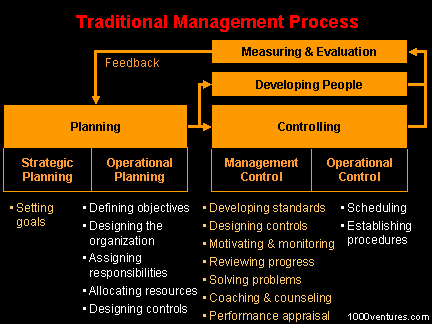|
| |
The
command-and-control, rigid, mechanical model
for simple mass-market businesses
|
|
 |
Setting
Objectives
An objective is a specific step, a
milestone, which enables you to
accomplish a goal.
Setting objectives involves a
continuous process of research and
decision making.
Knowledge of yourself
and your unit is a vital starting point in setting objectives...
More
→
Stretch Goals
|
| |
Organizing the
Group
Unless the way in which your unit,
or
group, is organized is suitable for its purposes and the people in it,
failure will result. Once you have set the objectives, analyzed the
activities, decisions, relations needed, and classified the work, divide it
into manageable activities and further divide the activities into manageable
jobs. Group these units and jobs into an organization structure, select
people for the management of these units and for the jobs to be done...
More
|
| |
Motivating and
Communicating
Motivation
depends on having clear objectives. Since motivation is personal, aim to
align staff's individual drives with the company's purposes in general and
your unit's in particular.
Many companies are filled with people who
don't know what the organization is trying to
accomplish
strategically. They don't feel that they or their contributions
are important, and just do what they must do, not what they are capable to
do. To unleash the power of your
organization and achieve exceptional results, you must
communicate
effectively,
empower employees,
encourage
intrapreneurship,
and
and motivate
employees to follow through on your
strategic focus...
More
|
|
| |
Measuring Performance
The basic purpose of any measurement system is
to provide feedback, relative to your goals, that increases your chances of
achieving these goals efficiently and effectively. Measurement gains true
value when used as the basis for timely decisions.
The ultimate aim of implementing a performance
measurement system is to improve the performance of the organization. If you
can get your performance measurement right, the data you generate will tell
you where you are, how you are doing, and where you are going...
More
Developing Yourself and Others
Developing people
starts with the self. Aim to be the kind of manager who gets the best
from staff, and who does the best for them.
>>>
Developing people is
achieved by careful
delegation of responsibility and
motivational
→
coaching.
Trust and know your colleagues. "Organizations are no longer built on force.
They are built on
trust." Rather than
relying on your powers, provide a spur,
use the powers within people...
More |
| |
Decentralization and
Delegation
At a certain point, there are just
too many facets to running a successful business to continue doing it alone.
In an increasingly complex business environment, with all the trends
affecting business today, such as globalization, the information technology
explosion,
strategic alliances, increased
mergers and acquisitions, heightened competition, and higher
expectations of nearly every customer, it just isn't possible to still be
that one person in control of everything. One person alone can't do
everything a growing business requires - at least not as quickly or as well
as it needs to be done.
Building a winning team and bringing in others to manage is an absolute
necessity for survival now.
The main principle of
decentralization is telling people what is to be done, but letting them
achieve it their own way. The
leaderr should concentrate on his or her core competence areas and only
do the tasks that nobody else can do. Other tasks should be delegated.
Delegation is the process that makes management possible, because management
is the process of
getting results accomplished through others.
A manager
should provide team members with the information they require to do a good
job,
communicating with them frequently, and giving them clear guidelines on
the results that are expected. Further, managers must also take the
"relationship responsibility" for those with whom they work...
More |
| |
Transition to the New Management Model
→
Leadership-Management
Synergy

These old traditional ways of managing not
longer work and will never work again. Old corporate organizational
structures – designed vertically, with matrix and ad hoc overlays – make
professional work too complex and inefficient.
In the new rapidly changing economy,
people have become your firm's most precious and underutilized resource.
They are your firm's repository of
knowledge and they are central to
your company's competitive advantage.
Well
coached, and highly
motivated people are critical to the development and execution of
strategies, especially in today's
faster-paced, more perplexing world, where top management alone can no
longer assure your firm's competitiveness. These new realities brought about
a new management model...
More |
|